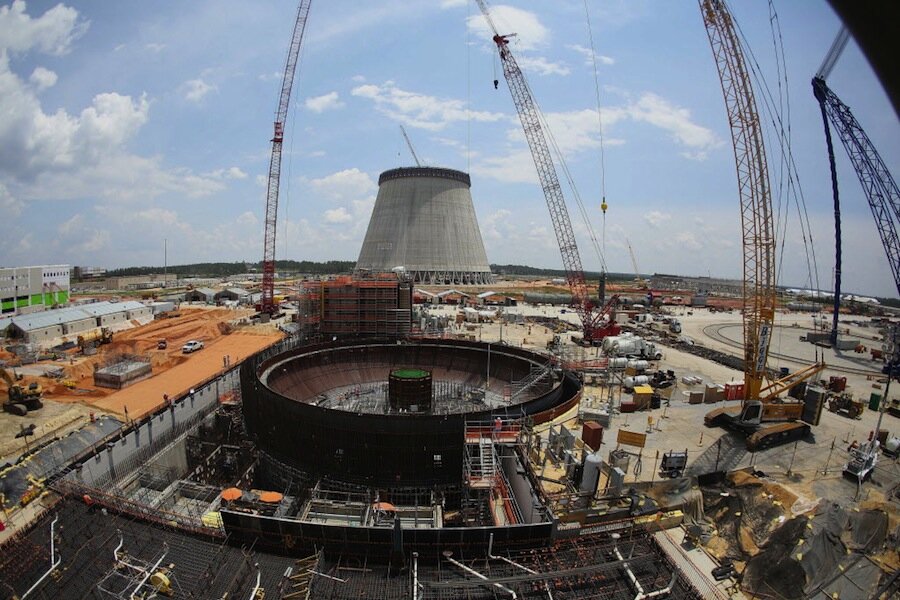As world expands nuclear power, US grapples with decades of waste
Loading...
| Washington
A nuclear power renaissance is underway in much of the world, but in the US you would hardly notice.
Shifting energy economics and public safety concerns have made new American nuclear reactors rare, even as China and others ramp up investment in the carbon-free power source.
But now, the US government is seeking to stay relevant in an evolving global nuclear industry, in part by proposing new ways to confront a decades-old challenge: handling mounting nuclear waste.
“If we want to continue to have low-cost, clean power from nuclear reactors, which today produce about 60 percent of our country’s emission-free electricity, then we have to have a place to put the used nuclear fuel,” Sen. Lamar Alexander (R) of Tennessee said in a statement Tuesday, after reintroducing a bill to create a nuclear waste management agency. “That means we need to end the stalemate over what to do with our country’s nuclear waste by finding a way to create both temporary and permanent storage sites that would complement other solutions.”
By law, the federal government must develop a long-term strategy for disposing of used nuclear fuel from commercial reactors and defense activities. But delays and political in-fighting have held up such a project for decades. In the meantime, most used uranium fuel is stored in lined concrete pools filled with water, or in airtight steel or concrete-and-steel containers onsite at nuclear reactors.
Combined, the nation’s 99 reactors make up about 20 percent of US electricity production.
Ultimately, the friction over nuclear waste comes down to one proposed project: Yucca Mountain. The Nevada nuclear waste repository has been in limbo for 30 years and is opposed by Senate Minority Leader Harry Reid (D) of Nevada and President Obama. There’s plenty of local opposition, too, as many in Nevada say the proposed site, which was designed to store both commercial and defense waste, was forced on them.
Calling Yucca "unworkable," the Obama administration is now pushing for a new path forward on nuclear waste disposal that emphasizes a “consent-based” approach and separate facilities for energy- and defense-related waste. The Department of Energy said this week it will seek interim storage sites for commercial waste and begin planning a permanent geological repository for defense waste.
“A separate repository for defense waste could allow greater flexibility in selection of a site, and greater flexibility could help keep costs down,” Energy Secretary Ernest Moniz said at a press conference Tuesday. “We think these steps are just common sense … The lack of a consent-based approach is pretty close to a fatal flaw in attempts to site these facilities.”
The nuclear energy industry applauded the developments and “the potential they hold to finally bring some progress to the nation's long-neglected nuclear waste management policy,” in the words of Marvin Ferte, president and CEO of the Nuclear Energy Institute, an industry group.
But some Republicans worry that separating defense waste – which makes up roughly 5 percent of total nuclear waste – from commercial waste is a “red herring” move to scrap the Yucca project altogether.
“Doing so is likely to cast aside the Yucca site with years of work and billions of dollars spent,” House Energy and Commerce Chairman Fred Upton (R) of Michigan said in a statement.
"Yucca Mountain remains the most viable solution for our nation's nuclear waste policy and it comes with the scientific community's seal of approval,” Chairman Upton said. “We passed bipartisan legislation some 30 years ago, and starting from step one looking for another site seems likely to delay a solution for years to come."
As the US struggles to work out how to dispose of radioactive waste, the rest of the world boosting its nuclear power investments. The 2011 Fukushima nuclear meltdown in Japan raised safety concerns that encouraged Japan and Germany to move away from nuclear, but the carbon-free source of power has been resurgent elsewhere, from the UK to China.
“Right now, the nuclear renaissance is happening, and it’s happening in East Asia,” Geoffrey Rothwell, an economist at the Organization for Economic Cooperation and Development, an international market and trade organization, told Foreign Policy.
There are 400 gigawatts of nuclear generation globally, according to the International Energy Agency, and 72 gigawatts of capacity are in the works. Nuclear is cleaner than coal- and gas-fired power and more consistent than wind or solar, which don’t producer power at night or when the wind isn’t blowing.
Lack of growth in the industry, as well as waste disposal difficulties, raise questions about whether the US will be able to compete with China and other countries that are aggressively pursuing nuclear.
China aims to have 58 gigawatts of nuclear up and running by in the next decade – a number roughly half of current US capacity.





